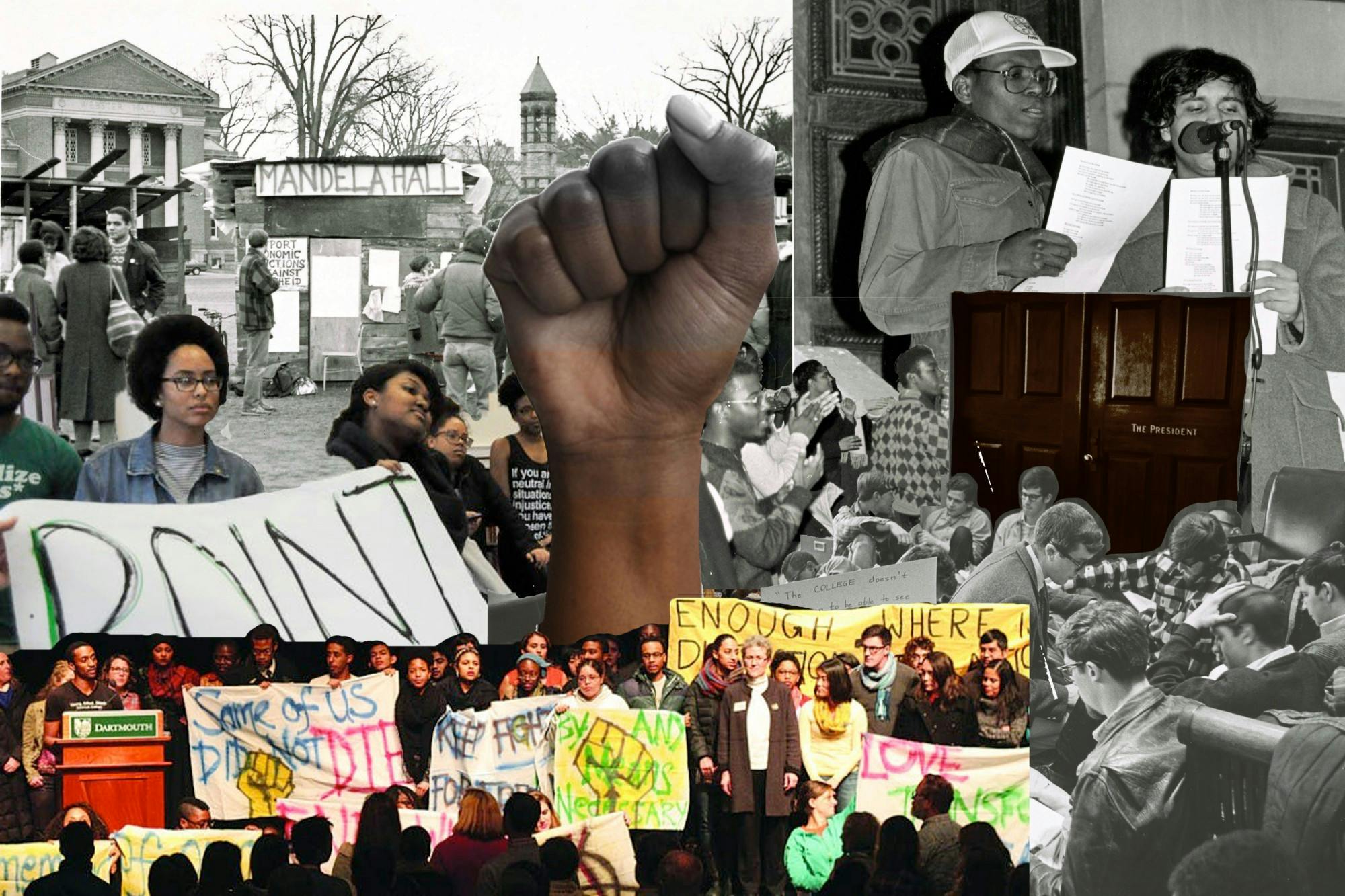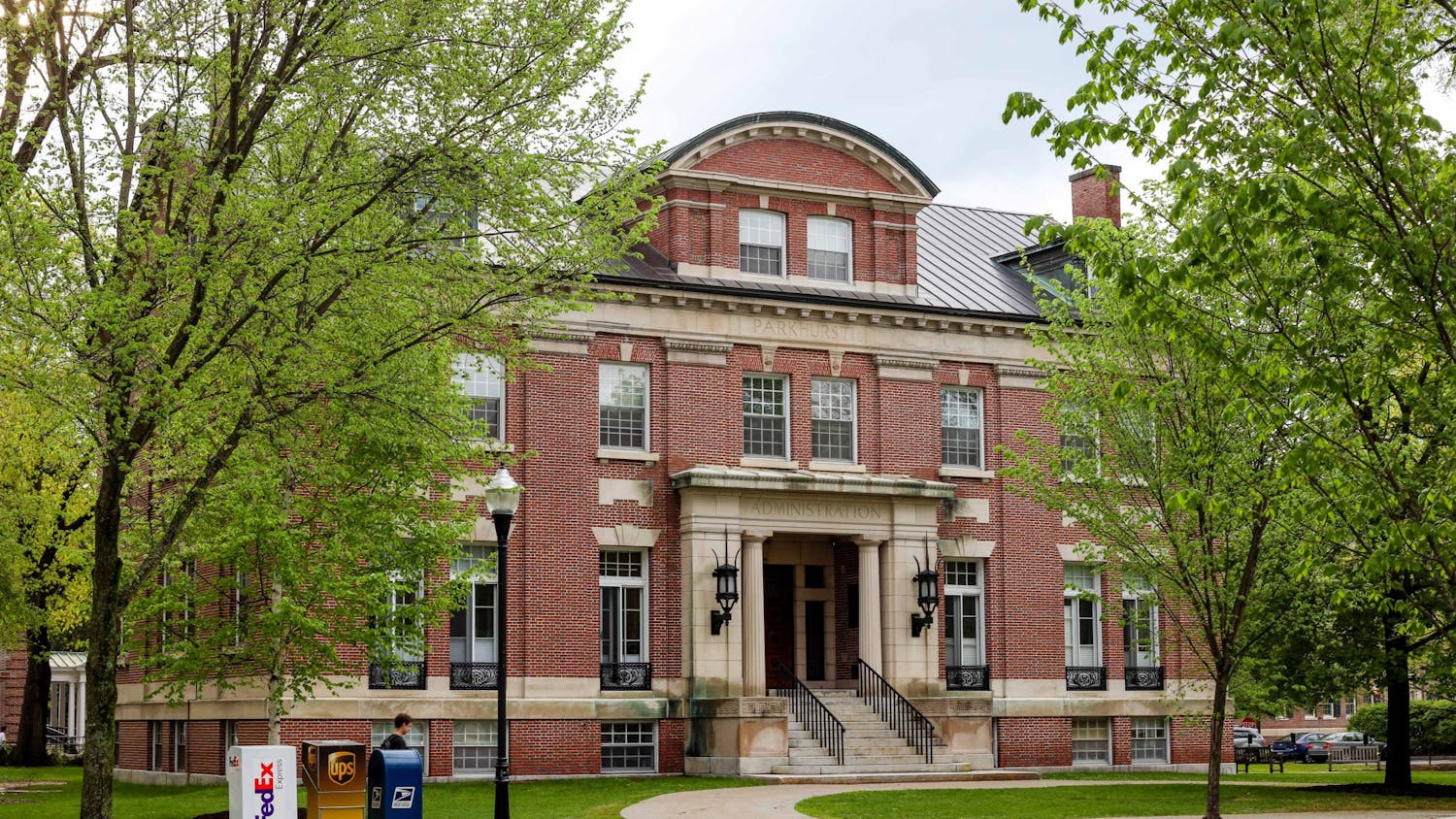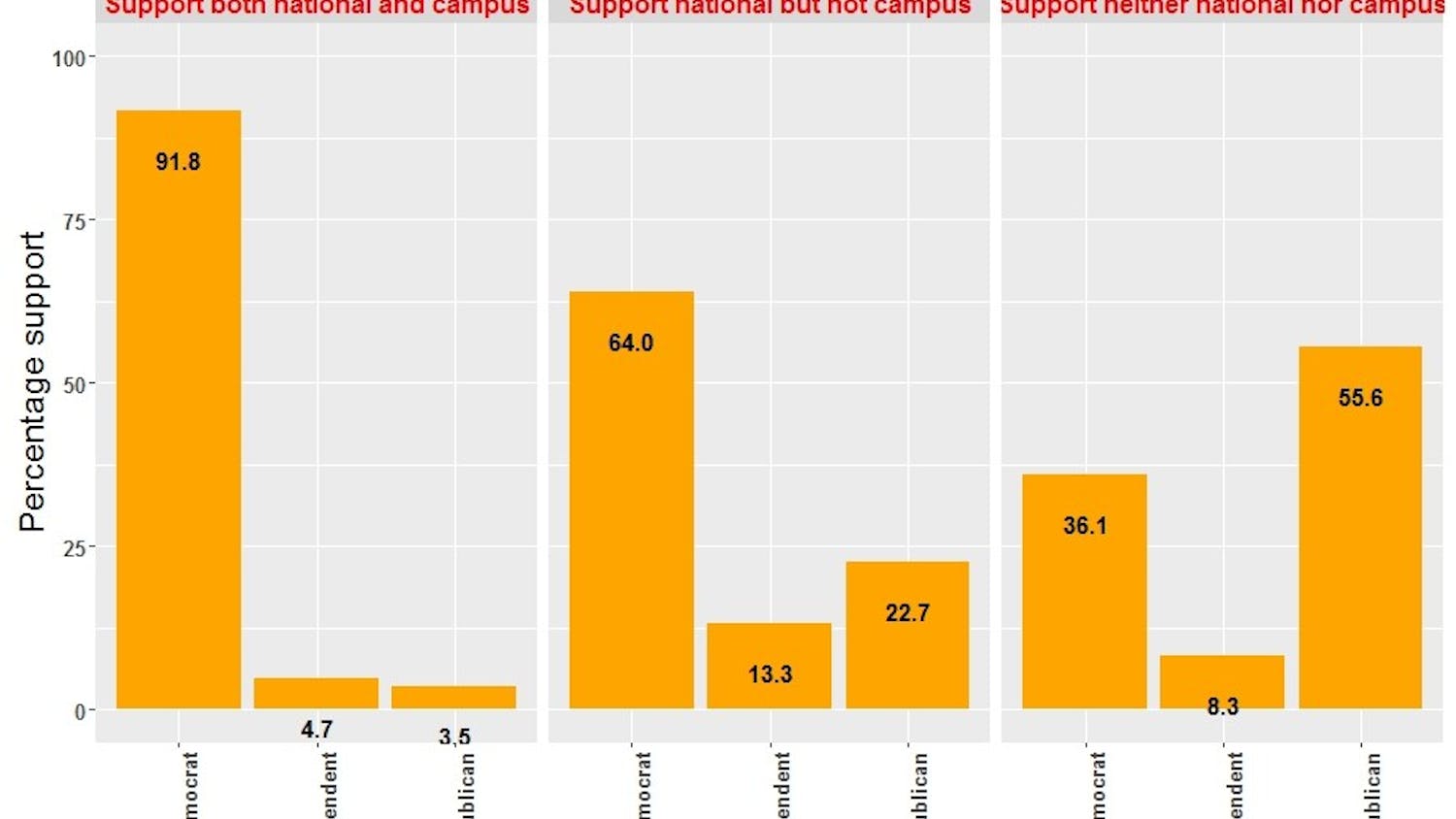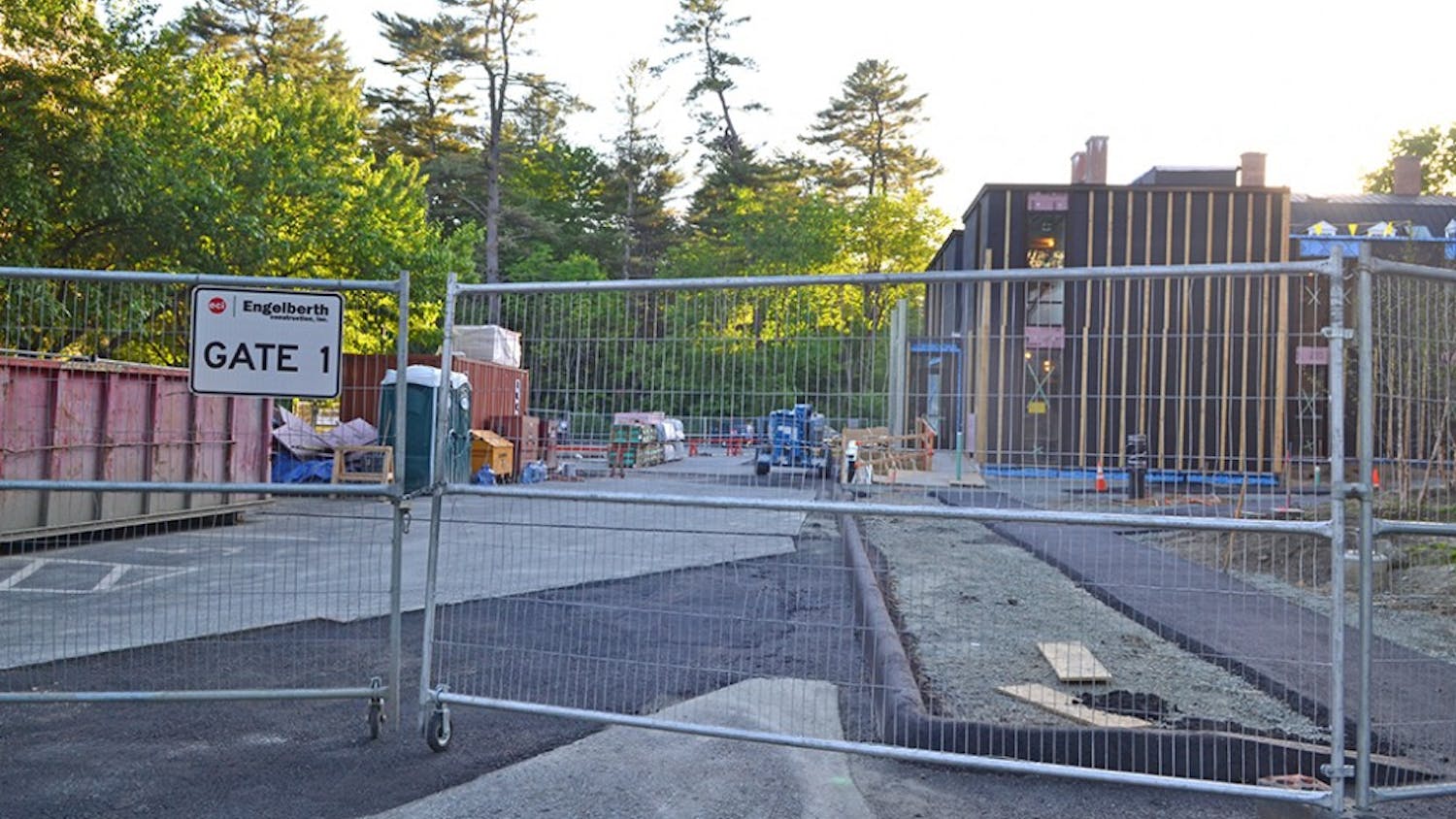This article is featured in the 2020 Freshman special issue.
Amid the nation’s continued reckoning with anti-Black racism in the wake of George Floyd’s death at the hands of police, Dartmouth has faced calls to examine the climate of its campus and prioritize racial justice.
But for many alumni, these demands feel far too familiar.
In June, when James DeFrantz ’79 first encountered a petition from Black alumni calling for the College to adopt a list of anti-racist measures, he said he “thought [he] was in a time machine.”
“It felt like something I could’ve seen 40 years ago,” said DeFrantz, who championed efforts against racism as president of the Afro-American Society when he was a student.
Though tucked away in its remote corner of the country, Dartmouth, many of its alumni point out, has never been shielded from racism.
These alumni contend that racism is woven into the College’s history — a history predating the College’s establishment in 1769, as Dartmouth founder Eleazer Wheelock built his college on the backs of slaves who cleared the woods and laid the foundations to make his vision a reality.
At various moments in Dartmouth’s history, the College has been forced to confront racial inequities that have endured on its campus. During these moments, student activists have often stood at the forefront of the fight for change.
Students speak out in the Civil Rights Movement's wake
Fifty years ago to this June, Wallace Ford ’70 approached the podium on the day of his graduation to give a historic speech — the first Commencement speech given by a Black man in the College’s history.
“We are gathered here this morning to celebrate what is supposed to be a great day, a day of significance and a day of meaning for all those involved,” Ford began. “But what does this day mean for us … the Black students who have survived the Dartmouth College experience?"
To Ford, “survived” was no exaggeration. A self-described “firebrand” civil rights advocate on campus, Ford held prominence as a columnist for The Dartmouth and a WDCR radio show host. Throughout his time at the College, he said that students attacked him both verbally and physically, even sending him death threats.
“Fights would break out when I would show up at any public event,” Ford said.
Activism quickly assumed an important role in Ford’s Dartmouth career. During his freshman year, George Wallace — an outspoken segregationist who governed Alabama during the 1963 Birmingham church bombing — made a stop on campus as part of his presidential campaign.
“This guy wasn’t going to come to campus without us really just raising hell,” Ford said.
As Wallace attempted to depart campus after his speech, Ford joined a group of students in rocking his car back and forth. The group disbanded after state troopers intervened.
Ford said the incident, which national news outlets picked up the following day, “introduced the nation to [the fact] that there are Black students at Dartmouth College.” The backlash from alumni was instant, according to Ford.
“Needless to say, the alumni went nuts,” he said. “It was like, ‘First of all, we didn’t even know you had Black people up there. Second of all, why aren’t they behaving?’”
Just a year later, the assassination of Martin Luther King Jr. forced Dartmouth to confront the racial tensions on its campus head on. As riots erupted across the country, former College president John Sloan Dickey canceled classes for a day.
In the wake of King’s death, Ford and other students worked to solidify and present demands for diversity and inclusion through the 1969 McLane Report, named after Board of Trustees member John McLane Jr. ’38. The report urged the College to increase its number of Black students, faculty and staff.
The implementation started “immediately,” according to Ford, with the hiring of Black professors and administrators, as well as the creation of an African American studies program.
At the same time, Ford stressed that the McLane Report did not bring about the watershed moment for which he and other students of color had hoped. Instead, white students and alumni met many of its suggestions with “a lot of resistance and pushback.”
Eileen Cave ’76 observed that many of the demands remained unfulfilled during her time at the College.
Cave — a member of the College’s first class of women — co-wrote a report with two of her classmates titled “Institutional Racism and Student Life at Dartmouth College” to alert the administration to the obstacles she and other students from minority groups faced on campus.
According to Cave, being both Black and a woman “added another layer of complexity” to her experience at the College, which often left her feeling isolated.
Through conversations with other women and Black students, Cave came to identify “patterns of institutional racism” at the College, which she outlined in her report. Among these patterns were “assumptions of minority student inferiority” in the classroom and limited access to on-campus resources and work opportunities.
“It is the College's policy or lack thereof that has allowed discrimination to flourish at Dartmouth,” Cave and her co-authors wrote. “… Therefore, the activity of the College towards the goal of achieving equality of opportunity should far exceed student grievances and recommendations.”
However, according to Cave, the report was “entirely dismissed.”
“Basically, the Trustee committee came back and said, ‘Not our Dartmouth. We don’t have these problems here,’” Cave said.
Though disappointed with the outcome, Cave said that the experience taught her a valuable lesson.
“In order to eradicate this institutional racism, it’s not enough to look to reform our practices,” Cave said. “There has to be a very intense and authentic commitment to reveal the history of what’s going on.”
Alumni recount “Winter of Discontent,” calls for divestment
In 1979, amid frigid temperatures and Winter Carnival festivities, tensions over racism at the College once again reached a boiling point.
DeFrantz, who followed in Ford’s and Cave’s footsteps as Afro-American Society president, recalled a cataclysm of racist incidents that seemed to pile up “all at once.”
As several Trustees arrived on campus, a maintenance crew dismantled the Afro-American Society’s ice sculpture — a graveyard symbolizing victims of South Africa’s apartheid state. According to the Dartmouth Alumni Magazine, the crew claimed they mistook the sculpture for debris.
The same weekend, two white students dressed as the “Dartmouth Indian” — the College’s former, unofficial mascot, which the administration had formally renounced years earlier — skated across the ice at a crowded Dartmouth-Brown hockey game as the band played Dartmouth’s “Scalp ‘Em” fight song.
The two events punctuated an already tenuous relationship between the College and students of color and women — the latter of whom were targeted in an advertisement run by The Dartmouth calling for submissions to Playboy magazine a month earlier. Following protests by the Women at Dartmouth student organization, The Dartmouth ran two cartoons insinuating that Dartmouth women were too unattractive to be featured in Playboy.
During this period of rising tensions, later dubbed the “Winter of Discontent,” the Afro-American Society, Native Americans at Dartmouth and Latino Forum held a rally in which protestors spray-painted the remains of the melting Winter Carnival snow sculpture in the middle of the Green.
Adrienne “Tee” Lotson ’82, a member of the Afro-American Society at the time, stressed the strong sense of urgency that students felt as they organized against racism.
“There were discussions that we could be thrown out of school if it didn’t go over well, and we didn’t care,” Lotson said. “It was like justice meant more than a Dartmouth degree.”
Threats against the protestors from outraged students poured in, prompting the College to send police to guard Cutter-Shabazz Hall, where the Afro-American Society was based.
Then College president John Kemeny swiftly declared a moratorium on classes in order to address the “rhetoric,” “intolerance” and “attempts at intimidation” on campus, according to a report from The Washington Post.
DeFrantz said that in lieu of classes on the day of the moratorium, students were encouraged to attend a series of teach-ins, seminars and speeches — one of which he gave — on the topics of racism and improving racial relations at Dartmouth.
“I said Dartmouth was a living hell for people of color,” DeFrantz recalled. “That was probably over the top in retrospect, but it felt that way at the time.”
A 1979 New York Times article reported that “white undergraduates largely boycott[ed]” the assembly.
According to Lotson, not only did campus remain “just as racist as it was before” in the Winter of Discontent’s aftermath, but The Dartmouth Review — a conservative student newspaper that has come under fire several times throughout its history for promoting bigotry — emerged in its wake.
“The message was clearly ‘How dare you claim space in a space that’s ours?’” Lotson said of the Review’s formation.
Maria Cole ’84 said that the Review created a climate of “toxicity and derision” on campus. She added that, in contrast to the campus climate at the time of the McLane Report, there “wasn’t that much intentionality around diversity and inclusion” at Dartmouth during the 1980s.
Cole and Sandy Broadus ’88 recounted that Review staff clashed with student activists numerous times during their years at the College. One of the most notable of these incidents occurred in 1986, amid continued protests against apartheid, the imprisonment of Nelson Mandela and the College’s investment of $64 million in companies conducting business in South Africa.
In the fall of 1985, a student organization called the Dartmouth Community for Divestment constructed four plywood shanties in the middle of the Green as part of an anti-apartheid demonstration. The shanties stood on the Green for over two months — until 12 sledgehammer-wielding students, 10 of them Review staffers, began to break them down while demonstrators were sleeping inside.
“It’s hard to imagine now that there would be people who would be agnostic, even much less antagonistic towards the idea of freeing Nelson Mandela,” Broadus said. “And yet there were.”
The shanties’ destruction became a “huge incident,” according to Broadus. Several major national news outlets covered the aftermath, which saw over 100 students occupy Parkhurst Hall in an over 30-hour sit-in to demand discipline for the students who tore the shanties down.
Calls for divestment continued throughout David McLaughlin’s tenure as president — a period that Broadus and Cole both recalled as stagnant in terms of social progress.
It was not until 1989, amid persistent protests under the presidency of James Freedman, that the College announced it would fully divest.
Broadus said that, although the change came after she had graduated, the decision still felt gratifying.
“I remember getting the news and thinking, ‘Damn it, I did that. I had a part in that.’” Broadus said. “I didn’t do it by myself, but had we said nothing, Dartmouth would’ve done nothing.”
Freedom Budget amplifies cries for justice, inclusion
Decades later, as the College geared up for its annual MLK Day celebration in 2014 — a day that Dondei Dean ’17 said has been “co-opted” to “tout that racism is over” — a group of student activists assembled to assert just the contrary.
Jalil Bishop ’14, then-president of the Afro-American Society and leader of the MLK Day protest, introduced College President Phil Hanlon on the day of the celebration. After Hanlon’s remarks, Bishop remained at the podium, stalling the keynote speech as he spoke for 20 minutes on Dartmouth’s failure to address the prevalence of racism and sexual assault on its campus.
“As you stand here and they ask you why you protest, tell them you have attended their talks, you have served on their committees, you have allowed your face on their brochures and still they did not honor your voice,” Bishop said.
According to Bishop, his interest in activism sprang out of the campus-wide discussions initiated by Real Talk Dartmouth, a student organization that staged protests calling attention to a variety of social issues on campus during the Dimensions admitted student performance.
The Freedom Budget — a list of over 70 demands calling for the College to “work towards creating a safe environment that would foster the communal responsibility and diversity the College claims to seek” — emerged in the wake of the Dimensions and MLK Day protests. Its authors came together from a variety of identity- and issue-based groups on campus, forming a coalition called the Dartmouth Action Collective.
“The Freedom Budget came from the experience of alumni … and lessons from our time on campus,” Bishop, one of its authors, said. “Dartmouth showed a complete inability to treat people with human dignity, so we created a coalition that was a model for what it meant to value people and then used that model to disrupt and challenge the College.”
Among the Freedom Budget’s demands were increased enrollment of students and hiring of faculty from underrepresented communities, a mandatory curriculum on social justice issues, a more transparent financial aid policy and improved support for sexual assault survivors.
Hanlon and then-interim Provost Martin Wybourne initially responded to the Freedom Budget with a statement pledging changes to financial aid and programs that would bring “diverse perspectives” to campus.
Unsatisfied with the statement, students held a two-day sit-in inside Hanlon’s Parkhurst Hall office, demanding a point-by-point response to the Freedom Budget.
Dean, who participated in the sit-in and assumed the task of presenting Hanlon with the document, said that defending the Freedom Budget to Hanlon was like “starting from scratch with someone who had never really thought about these things before.”
Ultimately, the administration declined to pass the Freedom Budget.
Instead, the College granted the protestors meetings with relevant administrators to discuss the broad topics highlighted in the document. At the time, one of the document’s authors described the pace of the College’s action as “maddeningly frustrating.”
In the ensuing years, racial tensions on campus have ebbed and flowed. Videos of a 2015 Black Lives Matter protest in Baker-Berry Library, in which protestors chanted and shouted at students studying in the library to stand up and join them, rocketed to national headlines — primarily among conservative news outlets that decried the protestors’ behavior as disruptive, unnecessary and violent.
Within the past two years, unidentified perpetrators graffitied racist slurs onto several students’ doors, and a group of students and professors were targeted with racist, sexually explicit emails.
And while the days of the anonymous online platforms Yik Yak and Bored@Baker have passed, the latter of which drew criticism after users posted lynching and rape threats, the anonymous forum Librex has sparked recent controversies, harboring racist comments targeted at a Student Assembly candidate in the last election.
In response to the nation’s latest wave of Black Lives Matter protests, the College announced it will “renew [its] institutional commitment” to “long-lasting change” by requiring implicit bias training for all students, faculty and staff, reviewing Department of Safety and Security policies and hiring more therapists of color, among other measures, according to a July 1 email statement.
Dean said she is not surprised by the recent resurgence of conversations around racism and white supremacy on campus.
“It’s all so cyclical,” Dean said.
Students, alumni discuss path forward
To Dean and many other alumni, Dartmouth appears trapped in a vicious cycle — one in which protests against injustice tend to be met with denial or harassment at worst and bureaucracy at best.
“A lot of the ideas that came out of the Freedom Budget are things we’re talking about now,” Cole noted.
This cycle often comes at the emotional expense of Black student leaders and activists, who endure racism and often graduate before the College takes action in response to their efforts.
“I went up [to Dartmouth] so naive and just so excited about the quality of the education I was going to receive,” Lotson said. “But save for a handful of professors, it was nightmarish.”
“There are a ton of alumni, especially Black alumni, who want nothing to do with the College,” DeFrantz echoed.
While she experienced many hardships as part of Dartmouth’s pioneering class of women, Cave says that she views the College as a “lifelong training ground” for engaging in advocacy.
Ian Scott ’24, who began organizing with the Dartmouth Student Union in the months leading up to his first year, similarly said that he appreciates activism as a forum that “creates space for students to be themselves.”
“For students of marginalized identities, there is so much strength that we can find in each other,” Scott said.
Even decades after graduating, many alumni and former student leaders have retained this sense of community, banding together in recent months to compile reports and advise the College on racial matters.
Members of the Class of 1979, for example, have formed a working group to discuss anti-racism at Dartmouth, according to DeFrantz. Cave currently sits on an ad hoc committee that has partnered with the Rauner Special Collections Library to document the history of the Black experience at the College.
In the face of criticism both past and present, many alumni activists stress that their efforts have never arisen simply from a desire to destroy the College’s traditions. On the contrary, they say their work has sprouted from the desire to improve Dartmouth, a place they once called home, for future generations.
“In my view, the work that I did — that unpaid labor — entitles me to claim [Dartmouth] even more,” Broadus said. “I think [student activists] should understand that not only did they pay their dues to get there, but they’re putting in sweat equity right now, in terms of the advocacy that they do for themselves and for other people. And they should wear that like a badge.”
Elizabeth Janowski '21 is the news executive editor of the 177th directorate. Hailing from Brookfield, Wisconsin, she is pursuing a double major in history and film and media studies.




